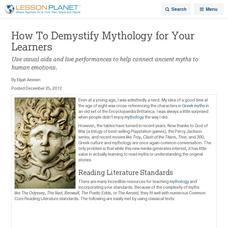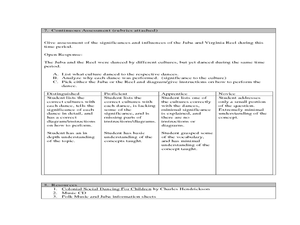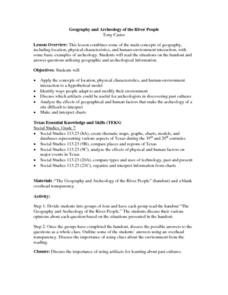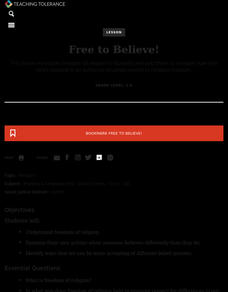Curated OER
Children's Book Creations
Students create a children's book version of the Japanese folk story "Momotaro Boy of the Peach" and present the story to elementary students. In this children's book lesson, students design their book to explain Japanese culture to...
Curated OER
Mystic Lands: Maya: Messages in Stone
High schoolers explore an ancient Mayan city. In this world history lesson plan, students watch a video about the ancient Mayan civilization, discussing information prior to and after watching the video. High schoolers then come to...
AMCO
Clay Face Masks
Let your class explore their sculpting skills with a lesson on making clay masks. Each step in the process is fully described alongside a helpful image. Kids of any ages will be able to construct fantastic representations of the human...
Curated OER
How To Demystify Mythology for Your Learners
Use visual aids and live performances to help connect ancient myths to human emotions.
Teaching English
In Flanders Fields
War is one of the most profound human experiences in history, and is often best depicted in works of art and literature. Introduce class members to the poetry of World War I with this resource that uses John McCrae's "In Flanders Fields"...
Curated OER
Native Design Coil Vase: Ceramics Lesson
After a quick study of Native American art, symbolism, and pattern design children make a ceramic vase. They read about the use, production, and design of Native American vases or pots, then use clay to create one of their own. Tip:...
Curated OER
Humanities in Colonial and Revolutionary America
Students demonstrate dances of colonial America. In this colonial American lesson, students learn forms of colonial social dancing including the Juba and Virginia Reel. Students examine the history of the 2 dances as well.
Curated OER
Geography and Archeology of the River People
Seventh graders work together in groups to read a handout and answer questions about the geography and archeology of a group of native peoples. As a class, they discuss their opinions and answers and the importance of using artifacts to...
Curated OER
A "State of the Arts" Coin K-3
Students recognize the U.S. penny, nickel, dime, and quarter by design, size, and denomination and that the portraits and other images depicted on the coins were designed by artists. They study common Texas symbols and choose one to draw...
Curated OER
Nomadic Living
Students describe what it means to be nomadic and the advantages and disadvantages of living this type of lifestyle. After watching a video, they pretend they are nomads and must develop a list of items to take along with them. They...
Curated OER
Indi/Visual
Eighth graders take photographs for a photo essay contest. Using primary source documents, they review various types of artwork and discuss how some of the images have become commonplace. They use the internet to view examples of...
Curated OER
Systems of Power Against and Within American Indian Communities, 1880-1940
High schoolers explore methods and the struggles of power between the federal policies and Native populations. They discuss the issue of controlling the Native Indian population, driving them from their land, and providing a mandatory...
Curated OER
Civil Society in Iraq
Learners use core questions to learn about the concept of a civil society. The dynamics of the war in Iraq serve as an example of a society that is in turmoil. They also develop an imagined society organization that would help promote...
Curated OER
Getting to Know You
Young scholars complete an getting to know each other activity. In this personal names lesson, students play a name game, read a book about names, and then discuss why names are important. Young scholars design a name card on oak tag...
Curated OER
A Sense of West Virginia
Students consider their perceptions of the world through their 5 senses while visiting the West Virginia State Museum. In this West Virginia history instructional activity, students discover how knowing about the past helps with their...
Curated OER
Esperanza Rising-Inferences
Sixth graders make inferences while reading. In this inferences lesson plan, 6th graders read Esperanza Rising and ask questions about the text.
Curated OER
The Tree Of Life
Fourth graders investigate the concept of forestry and how trees are used for different purposes. The problem of deforestation is presented in this historical lesson. The comparison of our society to others that depend on forests are...
Curated OER
People of the Past
Students investigate the four groups of people that existed in the U.S. before the European settlers arrived. They predict how the people arrived in the U.S., then investigate their predictions to find out whether or not they are...
Hildegard Center for the Arts
Mardi Gras Masks
Laissez les bons temps rouler! Create your own festive Mardi Gras masks with a lesson that provides background information on the celebration and instructions about constructing the masks.
Teaching Tolerance
Racial Disparity in the Criminal Justice System
Explore the impact of the war on drugs in a thought-provoking lesson for high school academics. Young historians delve into the world of the criminal justice system and the racial disparity that occurs in the US. The resource provides...
Teaching Tolerance
Understanding the Prison Label
Break the chain. An engaging lesson examines why it is so hard to break free of the prison system in the US. Academics participate in a reader's theater, read primary sources, and discuss their thoughts. The lesson explains the hardships...
Learning to Give
What Are Your Thoughts?
The varying responses of the characters in Mildred Taylor's Roll of Thunder, Hear My Cry to the discrimination they experience or perpetrate provides readers with an opportunity to not only examine the feelings of the characters but...
Facing History and Ourselves
Insights on Democracy from South Africa
As part of their study of democracy, high schoolers listen to a podcast featuring two South African educators and their efforts to support the process of transforming the nation from apartheid rule into a democracy. Learners also read...
Teaching Tolerance
Free to Believe!
The United States: One nation with countless religions. An interesting lesson focuses on the freedom of religion protected under the First Amendment. Academics learn why it is important to protect all religions, why there is a separation...























